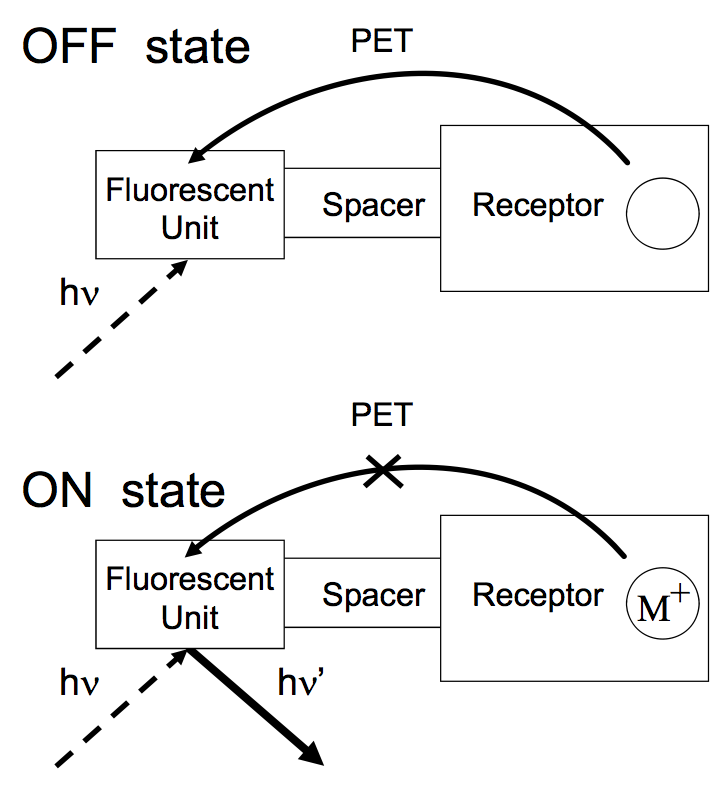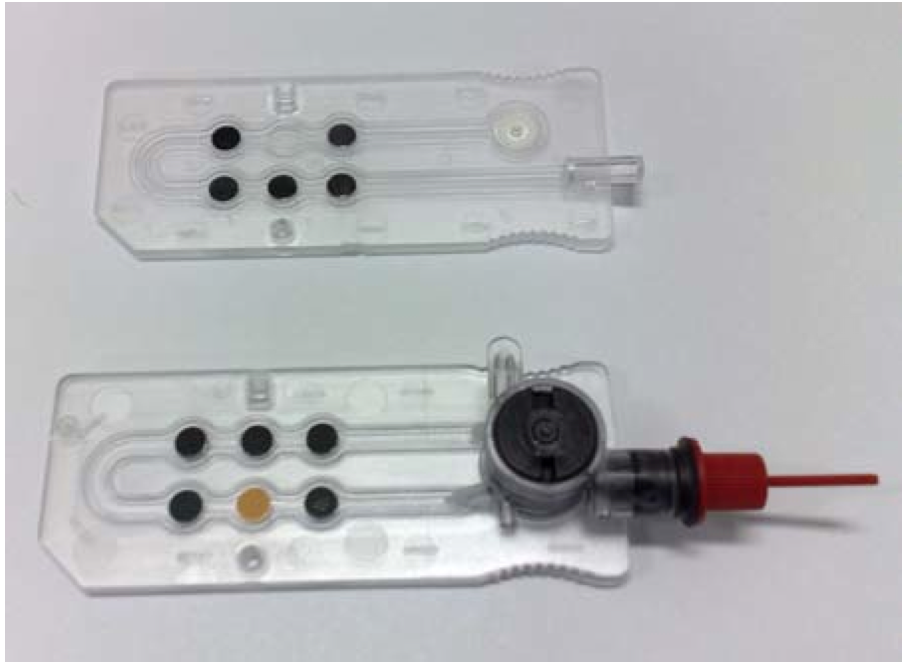Utilisation of Fluorescent PET (Photoinduced Electron Transfer) Sensor Molecules in Blood Analysis
Submitting Institution
Queen's University BelfastUnit of Assessment
ChemistrySummary Impact Type
TechnologicalResearch Subject Area(s)
Chemical Sciences: Macromolecular and Materials Chemistry, Physical Chemistry (incl. Structural), Theoretical and Computational Chemistry
Summary of the impact
Research on fluorescent PET sensors by de Silva at Queen's University
Belfast was directly, and
collaboratively, built into the Roche/Optimedical OPTI blood electrolyte
analyser, which has had
sales of US$50M in the past five years equating to 10 million sensors
sold. The market for this
sensor is global and it is used every day worldwide in hospital critical
care units, ambulances,
general-practice surgeries and veterinary care, often in life or death
circumstances. The research,
therefore, has led to both economic impact as well as significant health
benefits.
Underpinning research
De Silva in QUB has been the pioneer of research into fluorescent PET
(photoinduced electron
transfer) sensors as a technique to target species such as protons, sodium
and calcium that are
crucial in many biological and medical contexts. The research at QUB which
started in 1993,
developed an understanding of the mechanism associated with PET sensors
(references 1 and 2
in section 3), based on Nobel Prize winning Marcus Theory which
explains the rates of the electron
transfer reactions. The mechanistic understanding obtained allowed the
design of a modular
sensor consisting of a fluorescent unit and a receptor unit joined through
a spacer molecule (Figure
1). When optically excited, this allows the transfer of an electron
to/from the fluorescent unit from/to
the receptor, as occurs in plant photosynthesis, so that fluorescence is
killed off. When the
receptor captures a suitable cation, however, such as sodium, the
increased positive charge
prevents the electron transfer, allowing fluorescence. Additionally, the
research demonstrated that
changes in conformation caused by species occupying the receptor can
enhance the fluorescence
switching effect. Critically, as a result of the understanding formulated
by the Queen's group, the
combination of components has been able to be manipulated to selectively
detect analytes at
concentrations as low as 10-7 M, thus enabling, for example pH,
calcium, sodium and potassium
ion concentration to be determined from the same sample in a flow through
system via a number of
sensors in series. Furthermore, the Queen's group OFF state PET
developed the fluorescent PET sensors to be designed so
that a substantial number of other cationic, anionic and
neutral species are also accommodated to trigger Spacer Receptor
fluorescence leading to the technology to be transferred to a
commercial process and the design of sensors and devices
for much wider applications, for example in the field of
molecular logic based computation (reference 3 in section
3), of which the initial sensors acted as YES gates. Other
molecules, which behaved as AND gates, (references 3-6 in
section 3) also emerged. From this research, Unit
Roche/Optimedical collaborated with the Queen's team to hf06e hf06e'
develop commercial sensors for sodium, potassium and
calcium which were tested in collaboration with scientists at
AVL Bioscience Corporation, Roswell, GA leading to the
final OPTI blood electrolyte analyser product.
 Figure 1 Mechanism of
PET sensor action
Figure 1 Mechanism of
PET sensor action
References to the research
*Signify the references
which best indicate the quality of the underpinning research
*1. Fluorescent switches with high selectivity towards sodium ions:
correlation of ion-induced
conformation switching with fluorescence function. A.P. de Silva, H.Q.N.
Gunaratne, T.
Gunnlaugsson and M. Nieuwenhuyzen, Chem. Commun. 1996, 1967, DOI:
10.1039/cc9960001967.
*2. New Fluorescent Model Compounds for the Study of Photoinduced
Electron Transfer: The
Influence of a Molecular Electric Field in the Excited State. A.P. de
Silva, H.Q.N. Gunaratne, J.-L.
Habib-Jiwan, C.P. McCoy, T.E. Rice and J.-P. Soumillion, Angew. Chem.
Int. Ed. Engl. 1995, 34,
1728, DOI: 10.1002/anie.199517281.
3. A molecular photoionic AND gate based on fluorescent signalling. A.P.
de Silva, H.Q.N.
Gunaratne and C.P. McCoy, Nature 1993, 364, 42, DOI:
10.1038/364042a0.
*4. Switching between molecular switch types by module rearrangement: Ca2+-enabled,
H+-driven
`Off-On-Off', H+-driven YES and PASS 0 as well as H+,
Ca2+-driven AND logic operations. J.F.
Callan, A.P. de Silva and N.D. McClenaghan, Chem. Commun. 2004,
2048, DOI:
10.1039/b405909c.
5. Membrane Media Create Small Nanospaces for Molecular Computation. S.
Uchiyama, G.D.
McClean, K. Iwai and A.P. de Silva, J. Am. Chem. Soc. 2005, 127,
8920, DOI:
10.1021/ja0513638.
6. Direct detection of ion pairs by fluorescence enhancement. A.P. de
Silva, G.D. McClean and S.
Pagliari, Chem. Commun. 2003, 2010, DOI: 10.1039/b305262a.
Details of the impact
Based on the seminal research undertaken by
de Silva, Roche developed, in conjunction with
QUB, a blood analyser which was commercialised
and has been the market leader in point-of-care
analyzers ever since (Figure 2). Throughout the
period 2008-13 this R&D programme has led to
sales of US$50M of the diagnostic cassettes
used in the OPTI device) (see reference 1 in
section 5) clearly demonstrating economic impact of
the fundamental research undertaken in QUB.
 Figure 2 OPTI cassettes sold by Optimedical Inc
(www.optimedical.com). The black spots carry the
appropriate sensor molecules covalently attached.
Figure 2 OPTI cassettes sold by Optimedical Inc
(www.optimedical.com). The black spots carry the
appropriate sensor molecules covalently attached.
As well as economic impact, the formulation of these sensors has had wide
spread health benefits
worldwide. "The sensors are used in various locations within hospitals,
emergency centers,
ambulances, helicopters, airplanes, pulmonary centres and in any location
where time critical
diagnostic testing is needed." (see reference 2 in section 5). For
example, they monitor blood for
levels of common salt components such as sodium, potassium and calcium
rapidly allowing
emergency units to arrange for a certain type of blood with the necessary
salt levels to be ready
following transport of a patient from triage to hospital, for example. The
ability to analyse the blood
rapidly (within 30 s) has also changed the working patterns of health
professionals, for example,
in Japan, general practitioners use the device to give patients results in
their surgeries rather than
have to send away blood samples for analysis. In addition, the technology
is so robust that
paramedics in ambulances in Sri Lanka used the Optimedical analyzer during
the civil war,
which ended in 2009, when casualties were a daily occurrence. These
devices have recently
been used in a similar vein in Libya (see reference 3 in section 5).
Furthermore, the technology
has been adapted for veterinary treatments and is incorporated into the
IDEXX VetLab Suite
demonstrating the breadth of the impact delivered (see reference 4 in
section 5).
The high quality fundamental research undertaken in the area of PET
fluorescent sensors by de
Silva in QUB has had significant economic impact benefiting both the
companies involved as well
as the wider economy. Importantly, there have also been health and
societal benefits to the
development of the OPTI blood analyser in terms of speed of the analysis
which has resulted in
patients' peace of mind and more importantly efficient life saving
transfusion of compatible blood
aiding the recovery of patients globally.
In 2008 Prof de Silva won the Royal Society of Chemistry's Award for
Sensors sponsored by GE
Healthcare for his contribution towards 'switch and tell' sensor
molecules, the invention of
molecular logic and the industrial impact of the research undertaken
(reference 5 in section 5).
Sources to corroborate the impact
- Supporting letter from Optimedical Company (which is the current name
of the Roche/AVL
Division) by Senior Scientist.
- http://www.optimedical.com/
- http://www.optimedical.com/news/2011/OPTI_Medical_Analyzers_In_Libya.pdf
- http://www.idexx.com/view/xhtml/en_us/corporate/investors/annual-review/2009/2009-opti-medical.jsf
- http://www.rsc.org/ScienceAndTechnology/Awards/Archive/SensorsAward/Index.asp